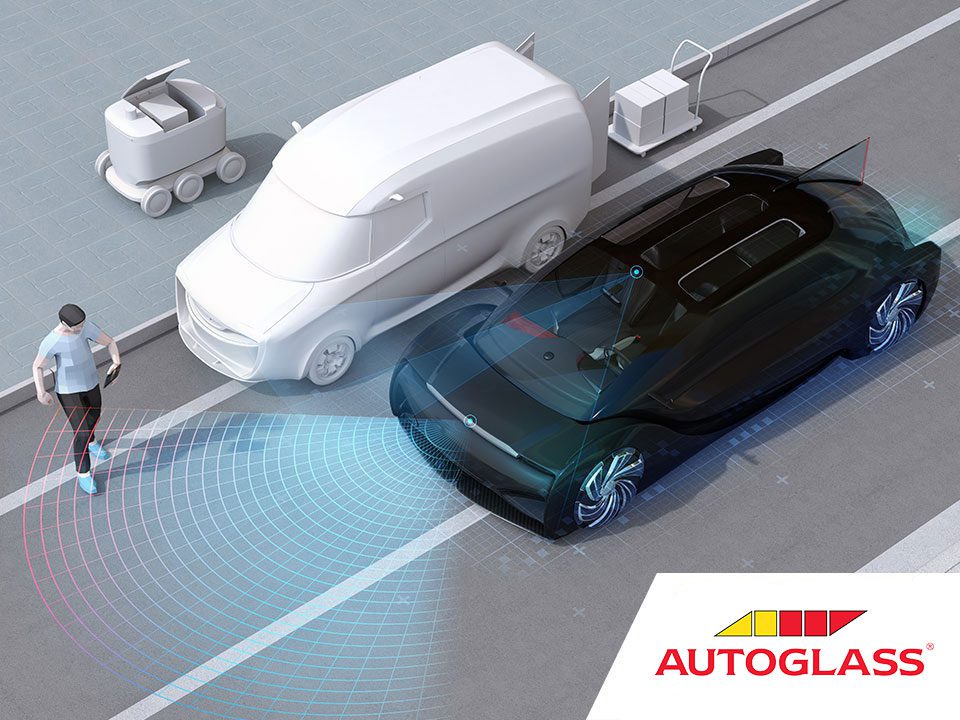
Common ADAS Features Explained
Buying a new car in 2022 can be a minefield for a myriad of reasons. Not least of all, the sheer breadth of new technologies that arrive on the auto market year after year. It is all too easy to be dazzled by the variety of futuristic technologies present in modern vehicles. Never fear, we here at Autoglass® have put together this handy explainer for many of the ADAS features and technologies you can expect to be offered in car dealerships throughout the country.
Take a look below to get familiar with just what is on offer.
Less Common ADAS Features Explained >>
Adaptive Cruise Control
Adaptive Cruise Control is a safety system that automatically controls the acceleration and braking of your vehicle based on monitoring other vehicles and objects on the road.
It’s up to the driver to select their preferred driving mode – for example, economical, comfortable – and so on. This information is combined with speed limits, road curvature, and more, and influences the automatically selected speed. The most up to the date intelligent cruise control systems aim to tackle the entire journey, managing the majority of the driver’s tasks whenever safe to do so.
Adaptive Headlights
Adaptive Headlights are car lights that actively respond to changing conditions as you encounter them on the road. Ultimately, they are designed with the goal of providing drivers with better visibility and more time to react to conditions ahead. The term Adaptive Headlights encompasses a variety of different features – most common of which being curve-adaptive headlights.
Curve-adaptive headlights work with bulbs mounted on specially designed motors which allow the bulbs to pivot. When the driver turns the steering wheel, or when sensors detect a curvature in the road, the position of the bulbs are adjusted accordingly. When the vehicle straightens up following the turn, so do the bulbs. Some curve-adaptive headlights also change the bulbs’ angle in relation to speed. As speed changes, the headlights point more up or down, casting light closer or further down the road.
The term adaptive headlights can also refer to other types of adaptation, such as automatic high beams. These headlights automatically switch between low beams and high beams in the presence of traffic.
Autonomous Emergency Braking
Autonomous Emergency Braking is a term used for systems that continuously monitor the road ahead and will autonomously apply the brakes if they detect any obstacle that doesn’t appear to have prompted any response from the driver. Many Autonomous Braking Systems use a combination of radar and camera technologies that are either positioned near the front of a vehicle or installed inside the windscreen.
AR and HUD – Future Windscreen Trends >>
Automatic Braking Systems
Automatic braking is a developing road safety technology that automatically activates the vehicle’s brake system, should the vehicle detect any hazards on the road.
Like many modern safety features, Automatic Braking Systems and associated Active Crash Avoidance Technologies use a multitude of top of the range sensors, cameras and radar to detect potential dangers and other road users..
If the driver fails to press the brake pedal, the vehicle can apply the brakes automatically. It is worth noting that not all autobrake technology is meant to completely prevent a crash. Some systems’ are expressly designed to slow the vehicle with a view toward lessening the severity of the impact.
Automatic Parking
Automatic parking (often referred to as Park Assist) uses sensors and/or cameras to scan the area surrounding your vehicle for a suitable space before parking the vehicle autonomously. Typically, the system controls the steering while the driver controls the pedals.
In some instances of parallel parking, the car will be able to get you out of the space as well. In fact, The most advanced parking systems can be parked via the car’s digital display key so you don’t even need to be in the vehicle at all.
Automotive Night Vision
Modern Automotive Night Vision Systems use a special thermographic camera to increase a driver’s seeing distance at night or in particularly bad weather conditions.
Blind Spot Monitoring
Blind-Spot Monitoring employs a set of sensors, usually mounted on the side mirrors or rear bumper of your car, to detect vehicles driving in the adjacent lanes.
Should the sensors detect a potential danger in your blind spot, they’ll alert the driver via an audible and/or visual warning. As the cost of the tech has gone down, the safety and convenience feature is now offered across the market—not just on luxury vehicles. Another recent upgrade to blind-spot monitoring is a change from passively warning to actively helping the driver avoid a potential collision. For example, if the car you’re driving detects a car next to you when you’re about to change lanes, it can manipulate the steering and brakes to try to avoid a collision.
Dynamic vs Static ADAS – what’s the difference? >>
Collision Avoidance Systems
A Collision Avoidance System is a safety system designed to alert or assist drivers in avoiding imminent collisions, reducing the risk of accidents on the road. Collision avoidance systems use a variety of technologies and sensors, such as radar, lasers, cameras, GPS, and artificial intelligence.
Drowsiness Detection
Driver Drowsiness Detection is a developing car safety technology which aims to do away with accidents caused by tiredness behind the wheel. Studies show that around 20% of all road accidents are fatigue-related. The technology works through monitoring the driver’s hands position on the steering wheel, the vehicle’s position in its lane and even the position of the driver’s eyes and face using the vehicle’s built-in camera or the driver’s mobile device.
Forward Collision Warning
Forward Collision Warning systems warn drivers of the potential for an impending collision by detecting stopped or slowly moving vehicles coming up ahead. Forward collision warning use radar, lasers, or cameras to scan the road ahead while you drive.
Some of the most advanced systems may also tighten seat belts and pre-charge the brakes in order to make it easier for the driver to come to a halt quickly as possible. Forward collision warning systems use both speed and distance calculations to appraise potential dangers and keep drivers safe. The most common type of distance sensor uses radar to detect traffic ahead of you, but some systems use lasers, cameras, or a combination of all these technologies.
Intelligent Speed Advice
Intelligent Speed Assistance is the catch-all term for any system that ensures that your vehicle’s speed does not exceed a safe or legally enforced speed. In case of potential speeding, the driver can be alerted, or the speed reduced automatically. Intelligent Speed Assistance usually utilizes live information about the road to determine the required speed in the moment. Many Intelligent Speed Advice Systems also provide information about driving hazards (e.g. high pedestrian movement areas, schools and hospital zones, etc.)
What is ADAS Windscreen Calibration? >>
Pedestrian Monitoring
Pedestrian Monitoring Technology essentially acts as an extra pair of “eyes” that helps keep drivers aware of the movements of pedestrians around their vehicle. The system analyzes the data from the radar and is able to detect for the specific “signature” of pedestrians that are about to cross in front of the vehicle.
If a pedestrian is detected and the vehicle is travelling less than 30 kilometre per hour, the system applies automatic braking to slow or stop the vehicle to help avoid a collision. If the vehicle is travelling between about 30 and 65 kilometers per hour, the Pedestrian Monitoring System alerts the driver with both audible and visual warnings. If the driver doesn’t respond, the system then engages automatic braking. It is worth noting that Pedestrian Monitoring Systems do not typically operate at speeds above 65 kilometers per hour.
Proximity Monitoring
Proximity Monitoring sensors are designed to alert you when your vehicle gets close to an object and typically fall under one of two different headings. Ultrasonic sensors use a type of sonar. Using echo-times from sound waves that bounce off nearby objects, the sensors can identify how far away the vehicle is from said object, and alert the driver the closer the vehicle gets. Electromagnetic sensors, on the other hand, create an electromagnetic field around the bumper of the vehicle, and offer an alert whenever objects enter that field.
Lane Departure Warning
Lane departure warning is designed to help you avoid crashes due to drifting or departing your lane. The system detects lane markings and alerts you when your tire comes into contact with said markings. The warning is usually a flashing indicator and/or a beep from the relevant side. Most lane departure systems use a camera positioned near the rearview mirror to recognize lane markers.
Rear View Cameras
A Rear View Camera is a special type of camera attached to the back of your vehicle to assist with reversing. When you shift your car into reverse, the Rear View Camera automatically turns on and a video display in your dash displays an image of the area behind your car.
All you need to know about ADAS >>
Traffic Sign Recognition
Traffic-sign recognition is a new and ever improving technology that enables vehicles to recognize the traffic signs you can expect to encounter on the road. The detection methods can be generally divided into colour based, shape based and AI computer learning based methods.
Turning Assistant
Turning Assistant is another new advanced driver assistance system. The system monitors opposing traffic when the Turning Assist equipped vehicle arrives at a junction – especially with a view toward avoiding collisions when turning left at low speeds. If the Turning Assistant sensors detect danger, the brakes are applied.
We hope that this quick guide has left you feeling a little bit more confident in identifying the ADAS features most relevant to you and your motoring life. Don’t forget to check back with the Autoglass® Blog soon for more guides, tips and explainers.
Book an appointment now
For a quick and easy way to make an appointment book online now.
